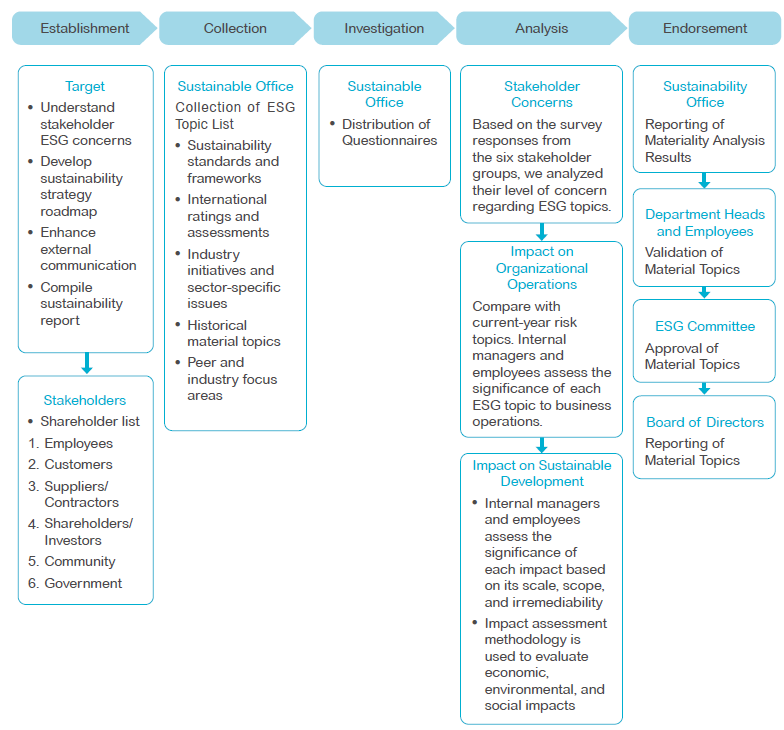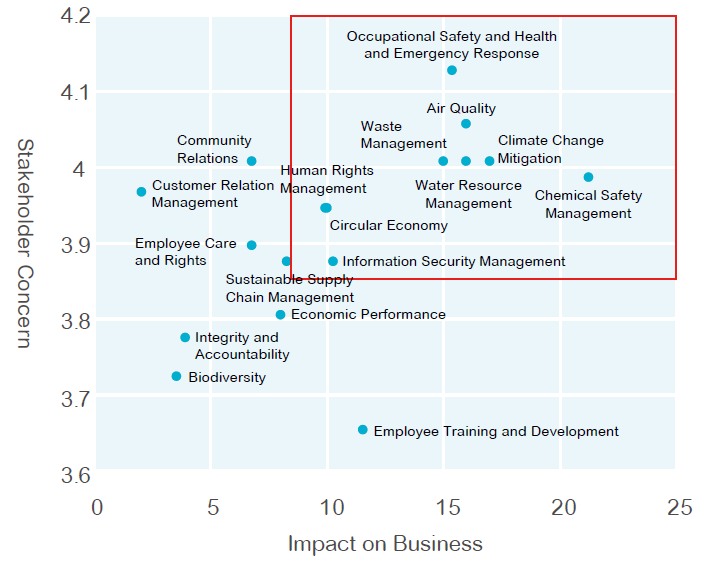Stakeholder Identification and Engagement
Process of Materiality Analysis
Nan Pao‘s materiality assessment process draws upon the AA1000 Accountability Principles (2018) and the GRI Sustainability Reporting Standards. The process adheres to four core principles: Inclusivity, Impact, Materiality, and Responsiveness. Guided by these principles, the Company applies a five-step process― Identification, Collection, Investigation, Analysis, and Validation―to review sustainability topics and conduct the materiality analysis. Sustainability issues are reviewed, and a materiality analysis is conducted every two years.
The double materiality approach considers both financial materiality and impact materiality. It examines how ESG topics present risks and opportunities that may influence the Company's development, performance, and market position from a
financial perspective, while also assessing the external impacts of corporate operations on the economy, environment, and people―including human rights. This report is prepared primarily based on sustainability impact materiality, and financial implications are assessed through a structured risk management framework.

Materiality Topic Identification Results
Based on the results of the stakeholder survey, Nan Pao analyzed the level of concern expressed by 546 stakeholders across a range of ESG topics. These results were visualized in the "Stakeholder Concerns Ranking" chart, which highlights the top ten ESG topics of concern. The highest priority topics identified include Occupational Safety and Health and Emergency Response, Air Quality, Climate Change Mitigation, and Water Resource Management, among others. These results have been incorporated into the double materiality assessment process.
Based on the survey analysis of 24 internal managers and employees, four topics were identified as having potentially
significant impacts: Chemical Safety Management, Circular Economy, Information Security Management, and Occupational Safety, Health, and Emergency Response. Among these, Circular Economy has the most notable impact on revenue growth and customer satisfaction; Chemical Safety Management and Information Security Management are highly correlated with operational risks; and the safety and health of employees and communities rely heavily on the implementation of Emergency Response measures, which include strengthening employee safety awareness, conducting regular emergency drills for all staff, and carrying out as well as monitoring employee health check results.
The result of 2024 materiality assessment is reviewed, approved, and supervised by Nan Pao’s Board of Directors.

•Highly Material : Set goals and regularly monitor management efforts.
•Moderately Material : Establish management policies and assign dedicated units for control.
•Lowly Material : Low short-term impact, but continuous monitoring is maintained.
Materiality and Impacts
NANPAO refers to the Global Sustainability Standards Board (GSSB) and evaluates the economic, environmental, and social impacts, as well as human rights impacts and their scope, based on the GRI 1 Foundation and GRI 3 Material Topics standards announced by the GSSB in 2021. These impacts can have both positive and negative effects and may be potential or actual occurrences that happen at different stages of the value chain, such as upstream procurement, company operations, and customer usage.

Integration with Enterprise Risk Management (ERM)
The results of the materiality assessment have been incorporated into the Company’s Enterprise Risk Management (ERM) framework. Each material topic is mapped to a specific risk factor, assigned likelihood and impact levels, and linked to defined responses/controls and management measures. Examples include:
|
Material Topic |
Risk Factor |
Possibility |
Impact |
Mitigation Measures |
|
Waste Management |
Improper waste disposal |
High |
Minor |
•Actively promote waste
recycling and reuse
•Select compliant treatment
plants, supervise waste disposal results, and conduct on-site inspections annually
|
|
Circular Economy |
Delayed new product development |
Low |
Normal |
•Establish clear R&D roadmaps
and allocate key resources
•Introduce external technologies
to overcome development bottlenecks
|
For more information, see the 2024 Sustainability Report, pages 22, 23, 46, and 47.
